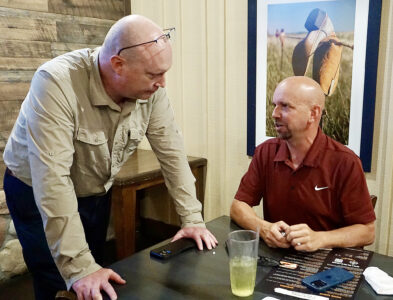Pursuing Minot’s problem properties
City improves strategy but more help needed

Gaylord Modin stands July 25 outside a poorly kept apartment building next to a house he is selling in Minot. Modin would like the City of Minot to require the neighbor to correct deficiencies.
Whether victims of damage or neglect, Minot’s problem properties are a headache for neighbors and a challenge for city staff charged with enforcing code compliance.
Recent figures from the city code enforcement officer showed 150 complaints about properties had been received this year as of mid-July for zoning or nuisance reasons, of which 44 remain active.
Although often driven by safety concerns, efforts to remediate problems can be time-consuming. Luke Tillema, building inspector for the City of Minot, said there have been situations in which the city has two years invested in working with property owners to bring about corrections.
“There’s some nuanced situations, too, where we’ll get compliance the first time. Then it starts building up again and we’re not getting compliance the second time or the third time,” he said.
“We have the constitution to work around with people’s personal property rights,” he added. “Everybody has the right to try to remedy the situation before there’s action taken against them.”

Signs warn the public this abandoned house in Minot is unsafe and trespassing is not allowed.
The city’s Problem Properties Unit, which had fallen by the wayside until restarted this year, meets once a month to discuss ordinance violations that create unsafe conditions for the public. The unit includes staff from code enforcement, building inspection, city police, fire inspection and First District Health Unit.
Tillema said the unit previously served to promote communication among zoning, building and health officials, but it has become more effective under the coordination of Assistant City Manager Tom Joyce.
“We actually have action happening,” he said. “I feel like we’re doing a better job than we ever have. Maybe it doesn’t look like that because it just keeps getting worse. We’re chasing the tail and we can never grab it.”
The city recently ordered demolition of a house that had been through two fires. It had not been repaired following the first fire and the second fire made it uninhabitable.
There have been other instances of fires, buildings damaged by vehicle crashes and in one case, a deceased owner who left family members without resources or legal ability to assume responsibility for the property.
If a property lacks water service or electrical service, health codes do not allow people to live there, Tillema said. Commonly, problem properties are not inhabited by owners or renters but may be housing squatters.
“It’s a two-faced issue in that regard because the opioid epidemic is definitely playing a part in all this,” Tillema said. “They all have their ear to the ground where these abandoned buildings are.”
Police are limited in their ability to patrol for every problem, but Joyce said neighbors can help. By reporting someone entering a sealed property or other potentially illegal activity, residents can help police respond in a timely manner, he said at a recent Problem Properties Unit meeting.
Seeing problems persist despite repeated complaints is frustrating for neighboring property owners such as Gaylord Modin, who lives in Bismarck but owns a property in his hometown of Minot that is for sale.
“I want to sell this house. I can’t because people come and look at it and they see that house next to it and they say, ‘This is a bad neighborhood,'” he said. “This is not a bad area.”
Modin, who has registered a complaint with the city, said he has attempted to identify code deficiencies in hope of bringing the rundown property, used as an apartment building, to the attention of the building inspector.
“I’m thinking about putting up a high fence to separate ourselves from that because I don’t know how soon the city is going to do something about this,” he said. “There are things I can do, and maybe I still will because I can’t just wait for something to happen to sell my property.”
Tillema said the Problem Properties Unit shares citizen concerns but must work within city ordinances.
“What the Problem Properties Unit is designed for is to sharpen our policies, to sharpen our ordinances so we can fill the gaps that are there, so the timelines aren’t as extended as they have been. I think we can do better,” Tillema said. “But we need help. I have one residential building inspector and one commercial building inspector and one mechanical and one plumbing inspector.”
Tillema also is assisted by a senior inspector. The 2025 proposed budget includes a part-time code enforcement officer to assist the one code enforcement officer currently on staff.
This year, the city has budgeted $68,000 to abate nuisances under the zoning code, which typically don’t involve structures, Tillema said. The budget includes another $50,000 to abate building code violations and nuisances, including demolition or removal of dangerous structures.
Abatement costs incurred are assessed to the owner’s property taxes, although that doesn’t guarantee payment.
“We’ve had a couple of years that we’ve pretty much spent our abatement budget and that’s pretty scary. And we’re going to definitely this year as well. This is the most active year I think we’ve had in the nine years I’ve been here,” Tillema said.
The Problem Properties Unit is looking for solutions to enable the city to more quickly address problem properties, he said.
“We are trying to find logical solutions that won’t impact responsible people,” Tillema said. “We just want a safe environment to live in, and clean. That’s not too much to ask. I think that’s the number reason for zoning codes, because we all want a safe, clean environment to live in and a nice neighborhood.”
- Gaylord Modin stands July 25 outside a poorly kept apartment building next to a house he is selling in Minot. Modin would like the City of Minot to require the neighbor to correct deficiencies.
- Signs warn the public this abandoned house in Minot is unsafe and trespassing is not allowed.





